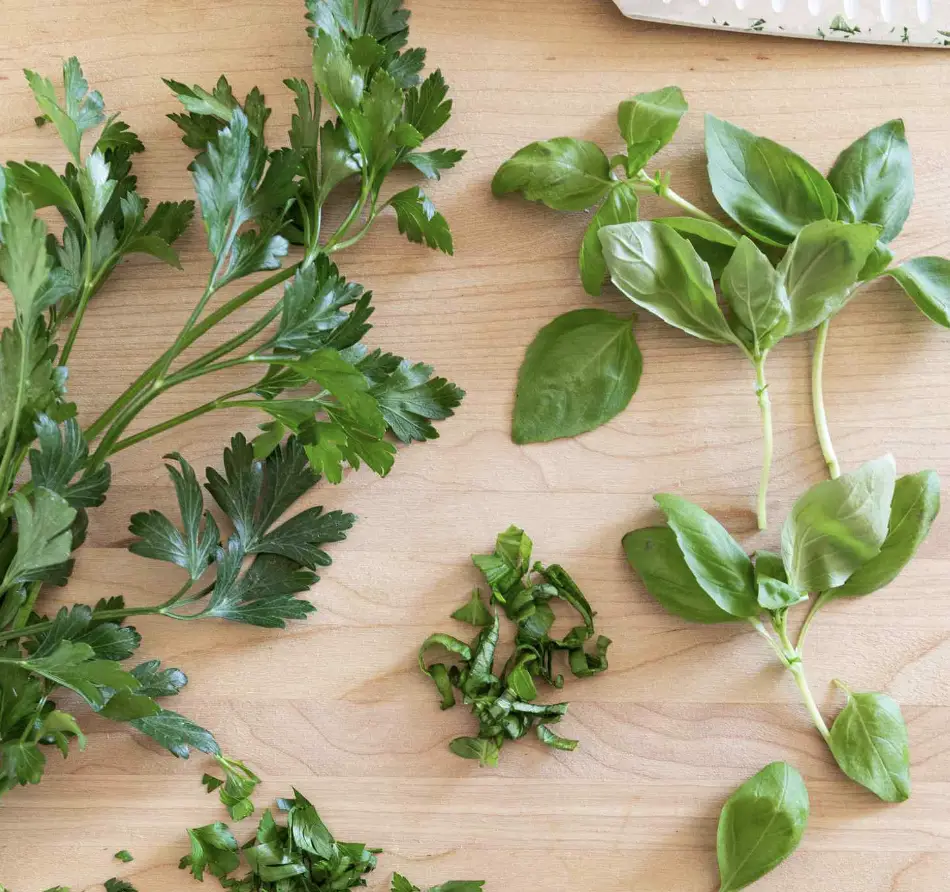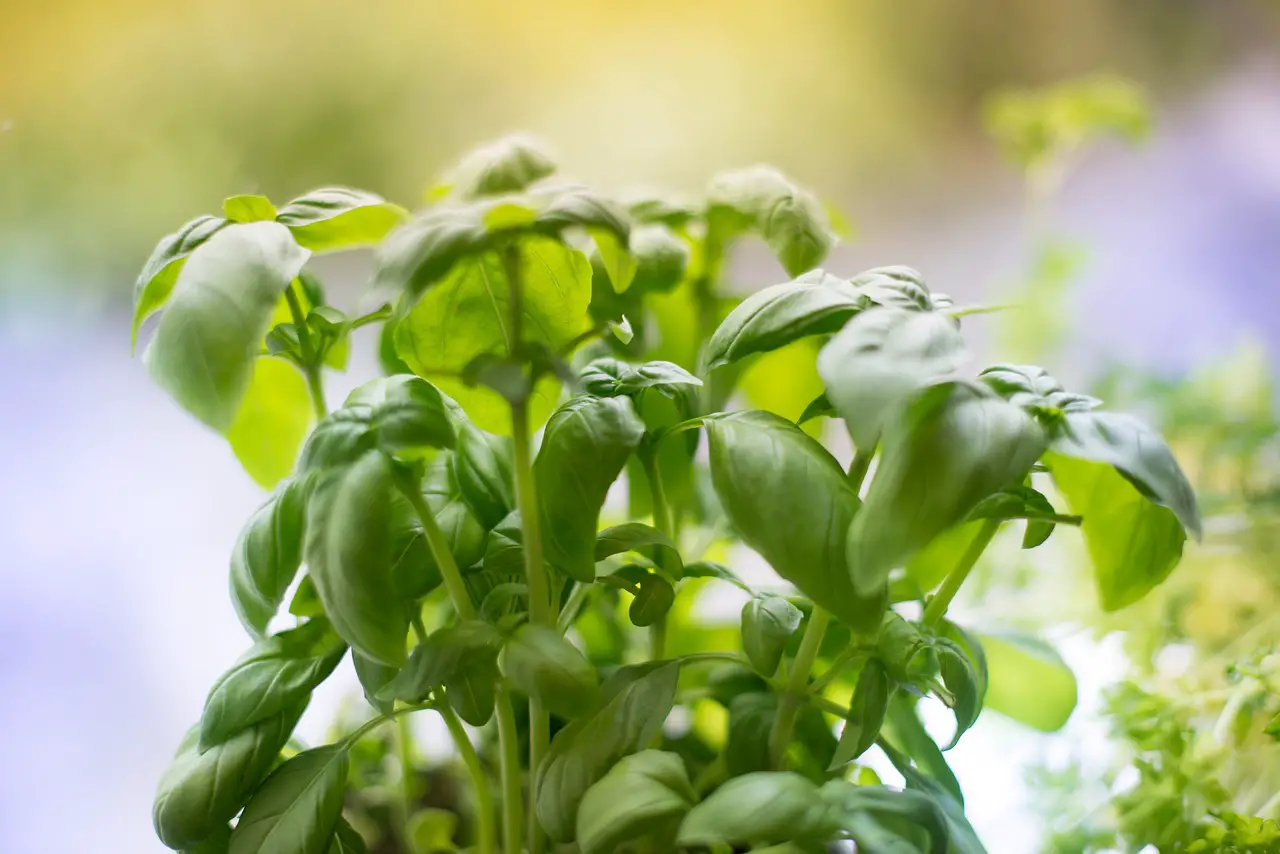
Join us as we navigate the rich tapestry of flavors offered by basil and parsley! At first look, these culinary staples might appear alike, yet they possess distinct traits that differentiate them.
Our detailed exploration will cover everything from their visual appeal and dimensions to their unique tastes, scents, and roles in cooking. We’ll also look into their health advantages, accessibility, and price points. Prepare to refine your culinary skills with basil and parsley, and unleash the true essence of these enchanting herbs in your dishes!
What Is Basil
Basil, known as the “king of herbs,” has a storied past that spans continents, from its origins in Asia and Africa to its prominence in Indian Ayurvedic practices and ancient Egyptian rites. It gained favor in Greek and Roman cultures for its aromatic qualities, and Renaissance Italian cuisine further solidified its status in Europe. Today, basil is cultivated in warm, sunny regions worldwide, including the Mediterranean, Southeast Asia, and the Americas, with varieties like sweet, Thai, and purple basil each offering distinct flavors.
In the culinary realm, basil’s fresh, sweet, and spicy notes enhance salads, sandwiches, pasta, and more, with essential oils enriching marinades and sauces. It shines in dishes like pesto, Caprese salad, and Thai green curry. As a versatile herb, basil can serve as both a garnish and a pivotal flavor component, often mingling with other herbs to create rich, aromatic blends suitable for a myriad of culinary creations.
What Is Parsley
Parsley, with its roots in the Mediterranean, has been celebrated by ancient Greeks and Romans for its culinary and medicinal virtues, often symbolizing vitality and used to protect against evil spirits at feasts. Known scientifically as Petroselinum crispum, this biennial herb from the Apiaceae family, akin to dill and cilantro, has found its way into global cuisines over millennia, now cultivated extensively in temperate regions like the United States, Germany, Israel, and Turkey.
Cultivated for its adaptability to various soils and sun conditions, parsley is indispensable in kitchens worldwide, available mainly in two varieties: the delicate, frilly curly-leaf and the more robust, slightly bitter flat-leaf. It’s celebrated for adding a fresh, vibrant touch to dishes such as tabbouleh, chimichurri, and gremolata, and for its ability to complement other herbs in seasoning blends like bouquet garni, making parsley a quintessential herb that enhances both the flavor and appearance of culinary creations.
Basil vs Parsley: The Differences
Appearance, Color, and Size
Basil, cherished in Italian and Thai cuisine, presents tender, slightly crinkled oval leaves, varying from 1 to 4 inches, with a vibrant green that may deepen upon cooking. Its delicate texture and subtle sheen make it distinctive.
Parsley, on the other hand, features feathery, flat, or curly leaves clustered together, typically 1 to 3 inches in length. Its lively green color remains consistent through cooking, offering a crisp, dense texture.
Summarizing, basil stands out with its soft, crinkled leaves, changing in color when heated, whereas parsley, with its clustered, feathery leaves, retains its bright green shade and adds a crisp texture to dishes.
Flavor And Smell
Basil, revered in various cuisines, delivers a sweet and slightly peppery taste with an anise touch, paired with a warm, distinctive herbaceous scent, enhancing dishes with its freshness. Its flavor and aroma intensify when dried or concentrated, yet fresh basil remains the most vivid in taste.
Parsley, offering a mild bitterness with grassy notes, has a fresh aroma that subtly enhances dishes without dominating. Available as flat-leaf or curly, parsley’s flavor is fairly stable across forms, with fresh parsley being more vibrant and dried parsley presenting a more subdued yet still herbal aroma.
Summarized, basil is known for its sweet, peppery, and anise-like flavors, with a notably warm aroma, whereas parsley has a milder, slightly bitter profile with a fresh scent. The flavor and aromatic intensity of both herbs are influenced by their form, with fresh versions providing the most dynamic culinary experience.
Use In The Kitchen
Basil is a key player in Italian, Thai, and Vietnamese cuisines, enhancing classics like pesto, Caprese salad, and Thai green curry with its unique flavor. It’s versatile, used in spice rubs, marinades, and as a garnish, and occasionally brightens cocktails like the Basil Smash.
Parsley, meanwhile, is fundamental in Mediterranean and Middle Eastern cooking, adding a fresh touch to dishes like tabbouleh and chimichurri. It’s commonly found in stews, salads, and as a garnish, contributing to the vibrant hue of juices and smoothies, and is a component in spice mixes such as bouquet garni.
In essence, basil is celebrated in Italian and Asian dishes for its aromatic contribution to meals and drinks, whereas parsley is a staple in Mediterranean cuisine, known for its ability to freshen and color a wide range of dishes and beverages. Both herbs are indispensable in the culinary world for their distinct flavors and versatility.
Health Benefits
Basil, packed with vitamins K, A, and C, along with essential minerals like calcium and magnesium, offers a spectrum of health benefits, including anti-inflammatory and antibacterial effects that enhance heart health and immunity. Yet, it’s important to enjoy basil in moderation due to its potential blood-thinning effects.
Parsley, equally nutritious, is rich in vitamins A, C, and K, plus minerals such as iron and folate, contributing to kidney and bone health and aiding digestion. Parsley’s benefits are best harnessed when consumed judiciously to prevent any kidney or liver issues.
In essence, both basil and parsley are nutritional powerhouses, each with unique health properties—basil for its heart-protective and immune-boosting qualities, and parsley for supporting kidney function and bone health. However, mindful consumption is crucial to avoid adverse effects, highlighting the balance needed in harnessing their health benefits.

Plant Varieties
For those not inclined to cultivate their own herbs, supermarkets typically stock fresh basil and parsley in the produce aisle, while dried versions are found alongside other herbs and spices.
Basil Varieties
- Classic Sweet Basil
- Compact Small Leaf Basil
- Vibrant Purple Basil
- Fragrant Scented Basil
- Sacred Holy Basil
Parsley Varieties
- Crisp Curly Parsley
- Robust Italian Parsley
- Smooth Flat-Leaf Parsley
- Unique Japanese Parsley
- Rooted Hamburg Parsley
Growing Basil And Parsley At Home
Soil
Basil thrives in conditions where the soil remains consistently moist, yet it’s crucial that the soil also offers good drainage to prevent waterlogging. Enhancing basil’s growing environment with a layer of mulch can significantly help in retaining soil moisture, ensuring the roots have access to the water they need without being submerged.
Parsley, on the other hand, shares the need for well-draining soil but with an additional preference for a slightly acidic pH, ideally around 6.0. This acidity level encourages optimal nutrient uptake, contributing to the healthy growth of parsley. Ensuring the soil meets these conditions can lead to a more vigorous and flavorful parsley harvest.
Light
Both basil and parsley flourish best when basked in full sunlight, crucial for their optimal growth and development. In the context of North America, this often translates to positioning these plants in a garden space that enjoys generous afternoon sunlight, preferably on the south side of a home. This placement ensures they receive the ample sun exposure needed to thrive, contributing to their health, vitality, and the enhancement of their flavors.
Watering
Basil enjoys a good watering regimen, thriving when the moisture is ample, provided the soil has adequate drainage to prevent water from pooling around its roots. This balance ensures the plant stays hydrated without becoming waterlogged.
Similarly, parsley requires consistent watering, particularly during the hot summer months prevalent in the United States. To aid in retaining soil moisture and ensuring the seedlings remain hydrated, applying a layer of mulch around them can be beneficial. This practice helps in maintaining an even soil moisture level, essential for parsley’s growth and development.
Harvesting
When harvesting basil, exercise caution to avoid removing more than one-third of the plant at a time. Taking too much can shock the plant, potentially stunting its growth or even leading to its demise. Regular pruning is essential for basil, particularly during the early stages of sprouting. Frequent trimming not only prevents overgrowth but also encourages a bushier, more productive plant.
For parsley, the ideal time for harvest is when the leaf stems boast at least three segments. It’s best to snip leaves from the plant’s outer portions, preserving the central part for continued growth. Allowing a 2-3 week interval between harvests gives parsley ample time to regenerate, ensuring a steady supply of fresh leaves. This methodical approach to harvesting ensures both basil and parsley plants remain healthy, vibrant, and prolific over their growing seasons.

Cooking With Basil And Parsley
Cooking With Basil
Garnish
Tear or chiffonade fresh basil leaves to scatter over completed dishes like pasta, pizzas, or salads, injecting vibrant color and aromatic zest.
Pesto Sauce
Blend fresh basil with pine nuts, garlic, Parmesan, and olive oil until smooth in a food processor. This quintessential Italian sauce is a versatile companion for pasta, sandwiches, or as a flavorful dip.
Infusing Oils
Warm olive oil with plenty of fresh basil, then cool; after straining, the basil-infused oil elevates salad dressings, drizzles, or sautéing with its enriched flavor.
Teas And Drinks
Steep fresh basil in hot water for a calming tea or muddle it into cool beverages like lemonades or cocktails, adding a refreshing herbal nuance.
Baked Treats
Mix chopped basil into doughs or batters for an inventive twist on breads, scones, or muffins, infusing a unique flavor into your savory or sweet baking endeavors.
Cooking With Parsley
Garnish
Dice fresh parsley leaves finely and scatter them atop completed dishes like pasta, soups, or roasted veggies for a splash of vibrant color and a delicate, fresh taste.
Sauces
Fold parsley into concoctions like chimichurri, gremolata, or salsa verde, where its lively, herbaceous flavor harmonizes with and offsets the sauce’s other elements.
Salads
Blend chopped parsley into leafy greens or incorporate it into grain salads, such as tabbouleh, for a burst of refreshing, earthy flavor.
Herb Butter
Mix softened butter with finely chopped parsley and select herbs to your liking, then slather on hot bread or dollop onto grilled meats and seafood for an infusion of herbal richness.
Soups And Stews
Stir parsley into soups and stews, either while cooking or as a garnish, to deepen the flavor profile and inject a note of freshness.
Pasta Dishes
Weave fresh parsley through pasta creations, like spaghetti aglio e olio or fettuccine alfredo, introducing a hint of brightness that balances the dish’s creamy or garlicky components.

FAQ
What Is The Best Substitute For Pasta
The best substitute for pasta depends on dietary preferences and goals. Options include spiralized vegetables like zucchini noodles (“zoodles”), spaghetti squash, whole wheat or legume-based pastas for more fiber, and grain alternatives like quinoa or rice noodles for gluten-free choices.
Is Cilantro The Same As Basil
Cilantro and basil are distinct herbs with unique flavors. Cilantro has a fresh, citrusy taste often associated with Mexican and Asian cuisines, while basil offers a sweet, peppery flavor, key in Mediterranean dishes, especially Italian. Their uses and tastes differ significantly.
Should I Put Basil Or Parsley On Pasta
Whether to use basil or parsley on pasta depends on the dish’s flavor profile. Basil adds a sweet, peppery taste ideal for Italian sauces like pesto, while parsley offers a fresh, slightly bitter touch, complementing a wider range of pasta dishes.

